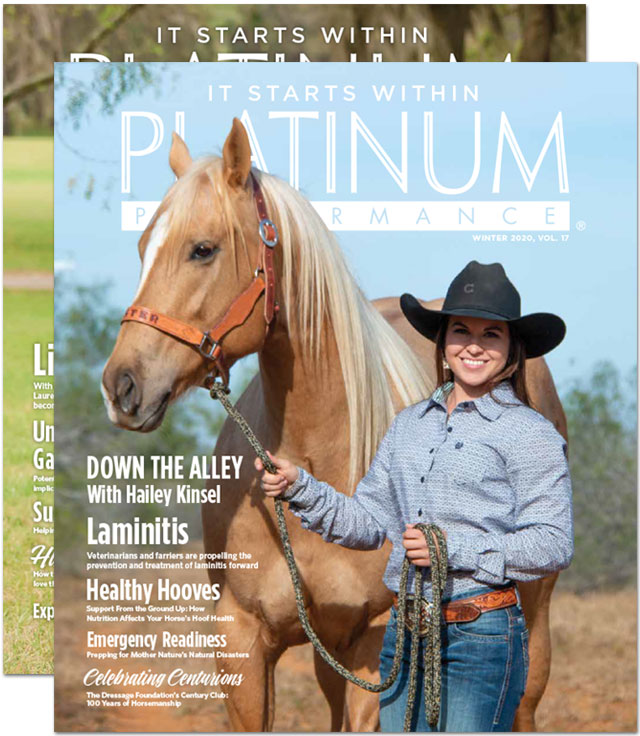Essential to Vital Systemic Functions, Vitamins Can Be Incredibly Fascinating and Relevant to Your Horse's Overall Health
You have likely heard the advice to “take your vitamins” and may have extended this wisdom to your horse’s health too. Much like minerals, vitamins are needed in relatively tiny amounts to provide vital systemic functions. These organic compounds are classified based on their solubility; that is, whether they dissolve in fats (vitamins A, D, E, K) or water (B vitamins and vitamin C).
Fresh grass is abundant with many vitamins. However, for horses that may have limited access to fresh forage throughout the year or are maintained on a hay-only diet without pasture access, vitamin supplementation will shift from prepared husbandry to essential as the potency of vitamins decreases with storage time of both forage and feeds. Being familiar with what is actually required of the horse is a good step to prevent the over- or underfeeding of vital vitamins.
There are several factors that may influence the recommended daily intake of an individual horse, including age, type and amount of exercise, reproductive status, as well as some external factors like access to sunshine and type and quality of feeds. It is well known across all species that vitamins are necessary and important to life and bodily well-being. But are some more needed than others, or which ones should be focused on for supplementation, if any? Some vitamins have semi-terrifying names (Ergocalciferol! Phylloquinone!) but after some simple education (or a quick review), they are not only easy to master but also fascinating and incredibly relevant to your horse’s health.
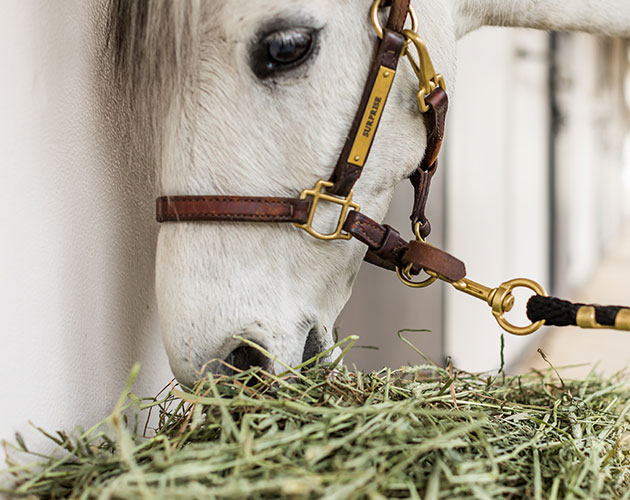
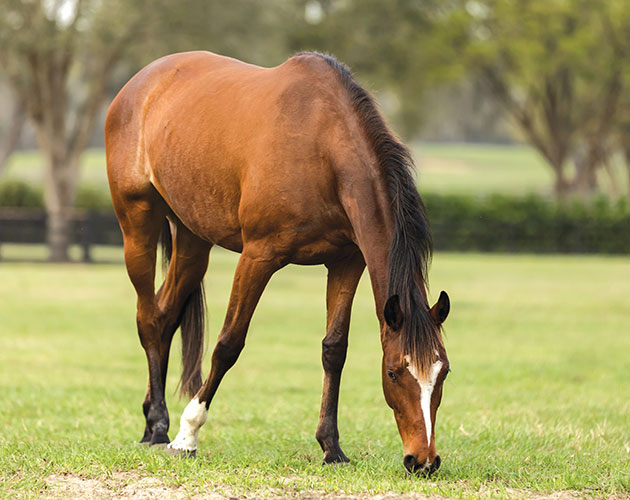
Vitamins: Fresh Grass vs. Hay
Fresh grass is abundant with many vitamins. However, for horses that may have limited access to fresh forage throughout the year or are maintained on a hay-only diet without pasture access, vitamin supplementation will shift from prepared husbandry to essential as the potency of vitamins decreases with storage time of both forage and feeds.
A
Vitamin A (ß-carotene)
Vitamin A is a fat-soluble vitamin that is actually converted to the usable form within the body by the horse. Its precursor, ß-carotene, is two vitamin A molecules linked together and, once ingested, are cleaved in the intestinal tract, allowing the individual vitamin A molecules to be available for absorption. ß-carotene is abundantly found in fresh pastures and carrots. Once hay is cut and baled, the levels of ß-carotene rapidly decrease with hay older than six months containing almost none of the vitamin A precursor.
Synonymous with vision, vitamin A is used by the retina in the eye to produce rhodopsin, which optimizes vision in poor lighting and allows horses to see keenly at night. A first sign of inadequate vitamin A is often impaired night vision. This well-studied vitamin has many other roles and is used in the mucus membranes that line the digestive, respiratory and urinary tracts. It also influences the lining of the reproductive tract and is needed to produce both sperm and eggs. Vitamin A is required for normal bone development. As an antioxidant, vitamin A destroys inflammatory free radicals, helping to keep the immune system functioning optimally. In nature’s perfect holistic way, vitamin A relies on other nutrients for ideal absorption, including the mineral zinc and vitamin E, which acts as a protector of vitamin A. Adequate dietary fat and protein are needed in order for the body to convert ß-carotene to its active form for absorption and utilization.
The National Research Council (NRC) publishes the Nutrient Requirements of Horses, widely considered the gold standard for current recommended daily intakes (RDI) and equine nutritional data. The current recommendation for vitamin A is 30 to 60 international units per kilogram per day (15,000 to 30,000 IU per day for a 1,100-pound (500 kg) horse) for all adult horses. Horses kept on pasture will likely not require additional vitamin A. However, horses that are stabled year-round without access to fresh grass, kept mostly on a grass hay diet or during winter when pasture may be limited or nonexistent will likely require supplementation for optimal health. Toxic levels of vitamin A are possible, particularly as actual vitamin A is added to feeds (rather than ß-carotene). The upper safe limit of the NRC is 80,000 IU per day for a 1,100-pound mature horse. Check labels if you are feeding multiple supplements together or if feeding significantly more than the recommended dosages.
B
B Vitamins (The B-vitamin complex)
There are eight total B vitamins in the B-vitamin complex that in large part work interconnected with each other. The B-vitamin complex is involved in virtually every cell and organ system within the body. The entire complex is essential to energy metabolism and used in several enzymatic pathways converting foods to fuel. The digestive and nervous systems, including the brain, rely on B vitamins. They are needed for healthy skin, coat and hooves and general protein synthesis. B vitamins influence red blood cells and are important for athletic horses. Broodmares also need them for healthy gestation and lactation. As water-soluble vitamins, they float freely in bodily fluids and, once absorbed in the blood, they circulate for cellular uptake or end up excreted in urine.
The NRC notes that B vitamins are usually supplied in adequate amounts for a mature horse by the microflora of the cecum and colon of the hindgut and through the ingestion of quality forages. As the hindgut microflora is a major contributor of all the B vitamins, it is important to remember that the health of the digestive tract is crucial for proper synthesis. Illness, stress or antibiotic use can impact the delicate microbe population and thus affect the B vitamin status. Fresh forages provide good levels of most B-vitamins as well, and, unlike vitamin C, they are stable and remain active especially in newly-baled hay. However, because B vitamins are water-soluble, if the hay is rained on or soaked to remove sugars, B vitamins (and vitamin C) will be leached out. Brans and yeasts, like Brewer’s yeast, are another source of B vitamins for the horse. Supplementation may be suggested for heavily exercised horses or during antibiotic use and high-stress situations (that is, illness, infection, surgery, travel or old age). It is often advocated to supplement the B-complex instead of individual B vitamins as they work closely together. Due to their water solubility, B vitamins have a very low toxicity level as excess levels will be efficiently filtered out by the kidneys and excreted. Vitamin B12 is the exception where small amounts may be stored in the liver. Deficiencies and toxicities have only been described in experimental settings.
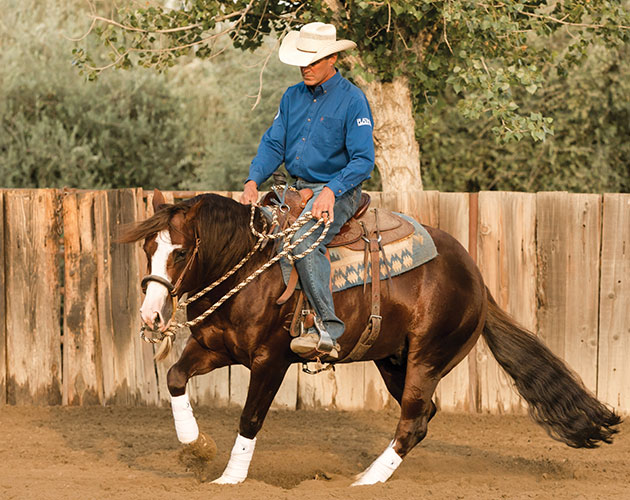
B Vitamins
Influence red blood cells and are important for athletic horses. Broodmares also need them for healthy gestation and lactation.
Meet the B Vitamins
B1 (Thiamin or Thiamine) is involved in numerous body functions by supporting the flow of electrolytes in and out of nerve and muscle cells and may assist in the performance and stamina of competition horses. It is used in the production of hydrochloric acid, necessary for proper digestion. At higher levels, thiamin is sometimes used as calming support for agitated horses. Relatively large doses of 1 mg per pound of body weight per day have been seen anecdotally to ease depression, anxiety and nervousness of horses. Interestingly, irritability and aggressive behaviors in humans have been associated with thiamin deficiencies.
Horses on a normal diet with a healthy functioning hindgut have not been reported to have deficiency symptoms, although suboptimal levels of thiamin may cause symptoms of nervousness, irritability, excitability or muscle cramping. The National Research Council (NRC) recommended intake per day for thiamin is 30 mg for adult horses and 50 mg for performance horses.
B2 (Riboflavin) is a constituent in antioxidant defense systems and involved in the production of immune cells. It is found in particularly high concentrations in legumes, like alfalfa and clover, as well as in some grass hays, although it is vulnerable to sunlight exposure. It is synthesized to great extent in the intestines by microbial fermentation. The current NRC recommendation for mature horses is 20 mg per day.
B3 (Niacin) is an essential coenzyme for biological reactions relating to energy transfer. One of these reactions is needed for several enzymes involved in DNA processing, cellular differentiation and the mobilization of cellular calcium. Like the other B vitamins, vitamin B3 is synthesized in the hindgut by microbes but can also be produced from tryptophan in liver tissue.
B5 (Pantothenic Acid) is an essential nutrient needed to make coenzyme A (CoA), a protein that can transport long carbon chains (acyl groups), such as fatty acids and, therefore, is particularly important for the making and breaking down of fats. Coenzyme A is involved in a variety of other metabolic pathways, including the creation of neurotransmitters and steroid hormones. There are no known toxicities or deficiencies, even at intakes as low as 2 mg per day.
B6 (Pyridoxine) is, like all the B vitamins, part of multiple enzymes necessary for the metabolism of carbohydrates, proteins and fats. It is also specially required to produce hemoglobin, the oxygen transporting protein in red blood cells.
B7 (Biotin) has a critical role in intermediary metabolism and broadly affects reproduction, the nervous system and thyroid and adrenal function. Important for cell proliferation, it is used, with vitamin B6, to produce keratin — the protein found in skin, hair and hooves.
Biotin is most well-known for its correlation with hoof health. Unhealthy hooves are not necessarily due to a deficiency of biotin, but supplementation with it can support hoof health. Several studies have been done in horses to measure health benefits from biotin supplementation. Typical recommendations of 15 to 20 mg per day for at least nine months are advocated for biotin supplementation to affect hoof health. At these levels, studies have seen increases in hoof wall growth rate and integrity, quality, hoof hardness and tensile strength.
B9 (Folate) is required for DNA synthesis and cell replication and becomes increasingly important to tissues with rapid cell turnover rates, such as skin, bone marrow and the lining of the digestive tract. It is used for the maintenance and production of red blood cells, as well as needed for neural development and the synthesis of neurotransmitters. Synthetic folate is commonly seen as folic acid.
It is thought that the needs for most horses in normal settings are met from forage and microbial fermentation. To note, the commonly used drugs to treat equine protozoal myeloencephalitis (EPM), pyrimethamine and sulfonamide antibiotics, purposely interfere with folic acid metabolism to prevent cellular reproduction of the causative protozoa. Supplemental folic acid should not be given in these cases.
B12 (Cyanocobalamin, Cobalamin) is involved in energy metabolism as well as promoting red blood cell production. Vitamin B12 is essential to the nervous system and is used to make the myelin sheath covering nerve cells. Some experts recommend B12 supplementation for nerve damage.
The only B vitamin that is not present in natural forages (only dietary sources are milk and whey), vitamin B12 is readily provided by the microflora in the gastrointestinal tract. Cobalt, a trace mineral, is required to synthesize vitamin B12.

C
Vitamin C (Ascorbic Acid)
Vitamin C has many vital roles in a healthy horse. The main biological role of vitamin C is as an antioxidant that prevents free radical damage and regenerates other antioxidants, like vitamin E. It is a natural antihistamine and supports a healthy immune system. As a cofactor, vitamin C is needed for the synthesis of several other molecules like carnitine, charged with escorting fatty acids through cell membranes to be used for energy or storage. It is also needed to make the amino acids, tryptophan, lysine and proline, all of which are critical for the normal production of collagen, a fundamental component of connective tissue and necessary for wound healing. Vitamin C is used to synthesize neural transmitters like norepinephrine, dopamine and serotonin and supports the creation of new red blood cells and hemoglobin needed for oxygen delivery to cells.
Unlike humans, horses are capable of synthesizing vitamin C in the liver from glucose to the extent that full-blown scurvy conditions do not occur in horses. Although there is not a firm daily recommendation for vitamin C, what is produced in the body is likely enough to satisfy what is needed for general health. Fresh grass provides dietary vitamin C but concentrations plummet in hay as vitamin C is unstable and will be readily destroyed by oxygen, sunlight, heat or moisture. Ascorbic acid is the form naturally found in food sources. Healthy horses in normal management settings will likely not require supplementation. However, there are several health situations where vitamin C supplementation may be warranted and provide needed support.
It is seen in other species that oral supplementation of vitamin C can decrease the body’s own synthesis. If supplementation is to be discontinued, it is suggested to wean off slowly, over a 3- to 4-week period. As a water-soluble vitamin, vitamin C is considered relatively non-toxic, although at high doses, it may cause digestive irritation and diarrhea. Common supplement dosages are 3 to 10 mg per pound of body weight daily or approximately 3 to 10 g per day for a 1,100-pound horse. The upper safe limit per the NRC is 20 g (20,000 mg) per day.
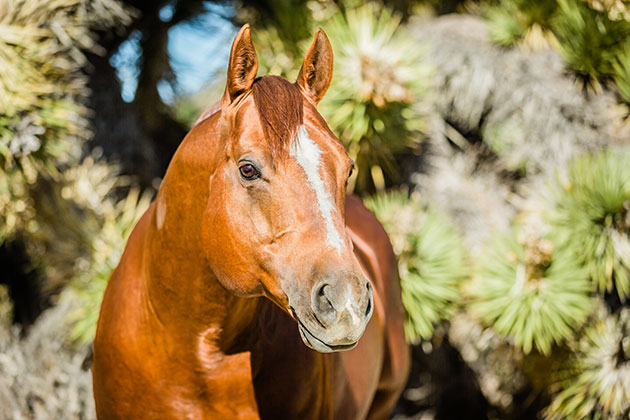
PHOTO BY NICOLE POYO
Supplementation with Vitamin C May Provide Support For:
- Poor Performance or Fatigue
- Injury, Wounds or Post-Surgery
- Immunocompromised or Infections
- Equine Asthma/Respiratory Distress
- Antibiotic Use
- Heavy Exercise
- Allergies
- Intestinal Issues
- Liver Function
- Seniors
D
Vitamin D (Calciferols)
Vitamin D goes hand in hand with calcium homeostasis. The “sunshine vitamin” promotes the absorption of calcium from within the small intestine and reabsorbs calcium and phosphorus via the kidneys. Vitamin D assists in bone calcification and the building of bone matrix by mobilizing both calcium and phosphorus into bones, particularly if the diet is low in these minerals.
The majority of the horse’s required vitamin D is supplied by skin cells in response to ultraviolet light exposure. Fresh plants, particularly alfalfa, and sun-cured hay provide vitamin D2 (ergocalciferol). Vitamin D3 (cholecalciferol) is found in animals and is the more common form used in supplements and fortified feeds.
It is presumed that horses with regular exposure to the sun will meet the maintenance vitamin D daily requirement, which, per the NRC, is 3,300 IU for a 1,100-pound horse. Vitamin D deficiencies have not been reported in horses managed in normal settings with adequate exposure to sunlight. Horses that are stalled primarily indoors with limited sun exposure may require dietary vitamin D assessment. A true deficiency of vitamin D correlates to low levels of calcium and phosphorus resulting in bone deformities, commonly known as rickets in both animals and humans, fractures and poor muscle contraction. Vitamin D toxicity is rare and usually only seen from excessive supplementation. Excess sun cannot cause toxicity. Toxic levels of vitamin D may result in the calcification and hardening of soft tissues and likely death. The upper limit is 44 IU/kg of body weight, which is 22,000 IU for a 1,100-pound horse.
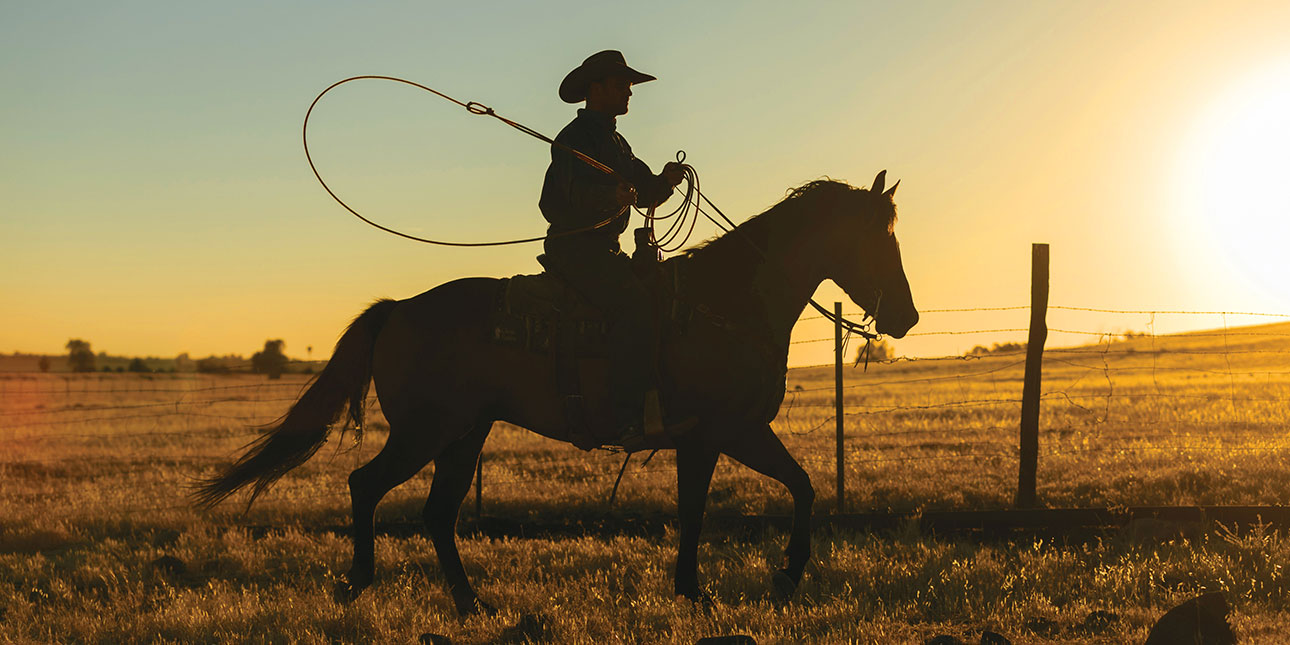
E
Vitamin E
Vitamin E is pivotal for the proper functioning of most equine biologic systems. The reproductive, muscular, nervous, circulatory and immune systems all rely on vitamin E to some extent. It is in every cell and is distinctive in its supportive role within the spinal cord, brain, liver, eyes, heart, skin and joints. Fats, which are an integral part of all cell membranes, are vulnerable to damage through lipid peroxidation by free radicals. As a major fat-soluble antioxidant, vitamin E’s lipophilic (fat-loving) nature allows its incorporation into cell membranes where it protects unsaturated lipids and other susceptible membrane components against oxidative damage.
Vitamin E is actually made up of two classes of molecules: tocopherols (saturated) and tocotrienols (unsaturated). Although both are available in the diet in several forms, α-tocopherol is the form most often found and preferentially absorbed in the body. For other vitamins, a synthetic source is basically identical to the natural source for both efficacy and structure, but this is not the case for vitamin E. The natural source of α-tocopherol is clearly preferred biologically in several ways. It is recognized to have significantly higher biological activity, is transported more quickly and stays in the tissues twice as long when compared to the synthetic version. When natural vitamin E is used in feeds and supplements, it is usually labeled as “natural” or “d” (for example, d-α-tocopherol or d-α-tocopheryl acetate, the esterified and stabilized form). Synthetic vitamin E will have an “l” designation, as in dl-α-tocopherol.
As it is not synthesized within the horse, vitamin E is considered an essential nutrient, and daily consumption is required to maintain adequate blood and tissue levels for cell protection. Fresh, green pasture grass, particularly alfalfa, is an excellent source of natural vitamin E. However, the levels of vitamin E plummet a staggering 86 percent when it is cut, dried and baled for hay. Other factors, such as maturity of pasture and length of storage time once baled dramatically diminish the quantity of vitamin E, with levels being seen to dive tenfold below that of fresh forage. For all horses that are without or have limited access to pasture grass, supplemental vitamin E will be required. This is especially critical management information for newborn foals and growing horses, gestating and lactating mares and performance horses that are being fed stored hay and kept stalled. As the vitamin E requirement is greater for these classes of horses, consuming hay only and being kept in confinement would make them more susceptible to vitamin E deficiency.
Chronic suboptimal vitamin E consumption may result in poor stress tolerance, subpar athletic performance, poor wound healing, muscle weakness and general suppressed immune function. Although most horses with a vitamin E deficiency may not show symptoms, true vitamin E deficiency is linked to several disease states, including several neuromuscular diseases. The symptoms of severe vitamin E deficiency include ataxia, peripheral neuropathy, muscle weakness and fasciculations and damage to the retina of the eye.
The current maintenance requirements for vitamin E per the NRC are approximately 1 IU/kg body weight or about 500 IU daily for an average-sized 1,100-pound horse. Vitamin E has little potential toxicity, even at high doses. However, more research is needed on its potential to interfere with other nutrients, particularly the absorption of ß-carotene. Because of this, the NRC recommends the upper safe limit to be 10,000 IU per day for an average-sized horse.
K
Vitamin K
Vitamin K is a cofactor for proteins necessary for blood coagulation and vascular (heart) health. It is also a cofactor for the enzyme that activates osteocalcin, a hormone that is stored in bone and used in metabolic regulation and several other endocrine functions. Vitamin K has a complementary relationship with calcium and vitamin D to support bone metabolism and resorption. Research in humans has shown positive results with supplementation of vitamin K and bone health, including a higher bone mineral density and reduced incidence of bone fracture. There is very little equine-specific vitamin K research and could be an area for future investigative opportunities particularly for bone health.
The two natural forms of the vitamin are phylloquinone (K1) that is found in plants and menaquinone (K2) that is produced by the intestinal microflora. Menadione (K3) is the synthetic form sometimes used in feeds or supplements. Pasture and hay are the biggest contributors of vitamin K (as K1) in a typical equine diet as the exact contribution from the gut is unclear. Daily vitamin K requirements for the horse have not been determined, but it is thought that amounts from forages and microbial contributions satisfy daily needs. Major symptoms of deficiency for all species, including horses, is impaired blood coagulation and hemorrhaging. Though uncommon, some anticoagulant drugs, like warfarin, can interfere with vitamin K activity. Because vitamin K is a fat-soluble vitamin, oral toxicity is possible in theory but has never been reported.
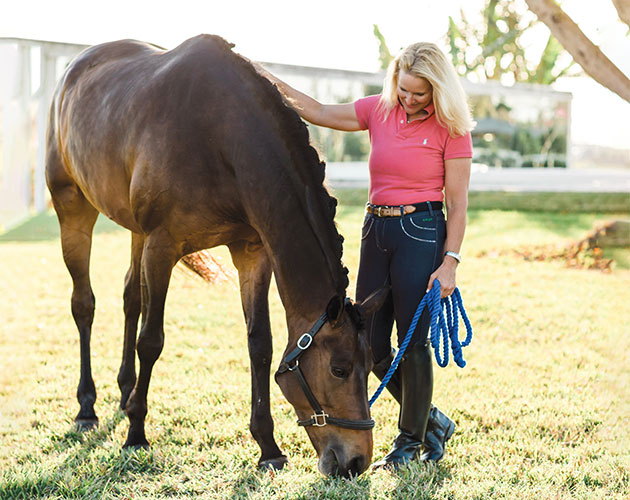

PHOTO BY SHANNON BRINKMAN
Vitamins and a Healthy Gut
The microflora of the hindgut produce several vitamins that go toward making a healthy horse. The B-vitamin complex, vitamin C and vitamin K are all synthesized to some extent by the gut.
It is critical to be proactive for the health of the gut and its delicate microbes that reside there. Providing a forage-based diet (or forage only!) provides the substrates needed for the complex and delicate flora to ferment and contentedly produce vitamins (as well as other nutrients).
Providing pre- and probiotics in the daily diet can help to keep the gut healthy and functioning optimally. This is essential to remember if the gut is ever compromised due to stress, illness or antibiotic use.
Take Your Vitamins
Unlike in human nutrition, firm requirements for many vitamins in the equine diet are still unknown with room for research. Daily requirements that are known, are, like other nutrients, likely affected by age, life stage, amount of exercise and stressors, such as intense exercise or illness. Supplementation needs for vitamins will be dependent on the quality of the diet, the amount of microbial vitamin synthesis and absorption in the digestive tract and the amount of sunlight exposure. Whether solidly known or waiting to be discovered, what is clear is the definitive difference between a minimal requirement to prevent deficiency issues and optimal support for wellness and performance. Vitamins are intrinsic in every system, every tissue and every cell. Because they are so heavily involved biologically, vitamins interact intimately with each other and with other nutrients in the body. Vitamins, minerals, protein, carbohydrates, fats and water are all equally influential to health. Likewise, as the whole animal is greater than the sum of its parts, equine nutrition requires a comprehensive, holistic approach as something small can have a big impact.

by Emily Smith, MS,
Platinum Performance®

